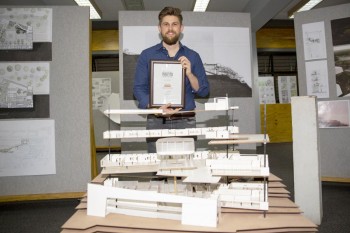De Jager Booysen (TUT) wins Regional Architecture Award
De Jager Booysen from the Tshwane University of Technology was the regional winner of the sought-after Corobrik’s Regional Architecture Award . Commenting on the Corobrik Architectural Student of the Year Award, Musa Shangase, Corobrik Commercial Director said: “As an organisation, we believe that ‘better starts here’, and this is particularly true for this award. These up-and-coming young architects are already designing iconic structures that would imprint their legacy on the country’s built environment. It is truly an honour to witness history being made.”
For the Corobrik Regional Architecture Award, De Jager Booysen received R10 000, with two people sharing the runner up place. Laetitia Lambrecht and Aldon Plaatjie will each receive R 7000 for their award. A further R 6 000 was awarded to Tiisetso Nkoana for his innovative use of clay masonry in the building design.
De Jager Booysen is one of eight young architects from top South African universities receiving a Corobrik Regional Architecture Award in recognition of their design talent and innovation throughout 2019. In addition to the cash prize, the regional competition winners are through to the finals of the National Architectural Student of the year Award – set to be announced in Johannesburg on 6 May 2020 – which comes with R70 000 in prize money.
De Jager Booysen’s dissertation, entitled Centre of Healing. Booysen says. “According to research, over 70% of the African population in South Africa relies on traditional healing methods as its preferred choice of medicine. Despite this, Western medicine is almost universally recognised as the only “official” treatment method in South Africa. For this reason, research on traditional healing methods has been largely neglected. This provides a unique opportunity for further research and education.”
The dissertation aims to provide a platform for traditional healing to be recognised as an official method of medical practice in South Africa. The proposed development aims to introduce a facility that focuses on three main components: Firstly, the research of rituals and medicines used in traditional healing practice; secondly, the administering of traditional treatment to patients; and thirdly, housing the educational process of becoming a traditional healer.
The design product could be described as a contemporary interpretation of an ancient spiritual space, stating the arrival of a new dialogue in healthcare sector. It strives to act as a monument that symbolises the shift into a new way forward in the field of medicine, using traditional methods to form the path into the future.
Runner-up Laetitia Lamprecht’s thesis is entitled ‘Abandoned Memory.’ It is the design of an intergenerational living and learning centre in Pretoria. Leatitia drew a parallel between old buildings and old people. The chosen site was the Old Jewish Synagogue in Pretoria. The topic was chosen to show how heritage buildings have a social impact and add value to urban environments. The same way that elderly people can add value by being included in societies.
Aldon Plaatjie’s ‘No Man’s Land’ is the design of a luminal space through the African Quadripoint. Plaatjie says, “African borders are reimagined with a floating trade platform on the Zambezi River. An alternative approach to African borders, where people are free to move, interact and trade without the imposed fearful border lines. I believe architecture can take a position of aiding in a progressive change through relooking at how to soften and remove hard physical and sociological borders and restore the dignity of the continent as a whole.
Best use of clay award was presented to Tiisetso Nkoana. The dissertation features the design of a centre in Hatherley, Pretoria (adjacent to Mamelodi) that seeks to create economic and skills development opportunities for the township residents serving as a solution to the environmental concerns facing a municipal dumping site. The thesis explored how architecture can contribute to creating economically sustainable communities. The use of brick demonstrated innovation in creating building materials.


